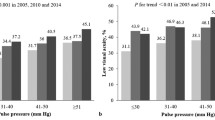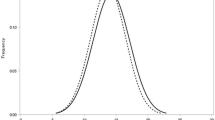Abstract
Background
Manifestations of neurocardiovascular instability (NCVI), including orthostatic hypotension (OH) orthostatic hypertension (OHTN) and impaired blood pressure variability (BPV), have been associated with cardiovascular (CV) events. The eye is highly vascular and we propose an ideal target end organ to investigate pathological implications of NCVI.
Objective
To identify and define clinically applicable phenotypes of orthostatic blood pressure (BP) behaviour, analogous to OH, OHTN, and orthostatic BPV and to investigate their relationship to vision.
Methods
Wave one data from the Irish Longitudinal Study on Ageing (TILDA) were used. Orthostatic BP (OBP) phenotypes were identified and defined from beat-to-beat BP data, measured by digital photoplethysmography during an active stand (AS) lasting 110 s (s). Visual acuity (VA) was assessed using the Early Treatment Diabetic Retinopathy Study (EDTRS) LogMAR chart. The relationship between OBP phenotypes and VA in 4355 adults aged ≥50 years was investigated through multivariate linear regression models.
Results
There was a wide fluctuation in the prevalence of OH and OHTN up to 20 s after standing. After 30 s, four distinct OBP phenotypes were identified: in 70 % BP stabilised to within 20/10 mmHg of baseline BP, 4 % had persistent OH, 2 % had persistent OHTN and 25 % had exaggerated orthostatic blood pressure variability BPV. Systolic BPV was associated with worse VA (P = 0.02) as was diastolic BPV (P = 0.03), following adjustment for demographics, health behaviours, self-report eye diseases and diabetes, uncorrected refractive error, objective hypertension and antihypertensives.
Conclusions
The hypothesis that NCVI may independently modulate CV risk is supported the independent association of exaggerated BPV and worse VA.


Similar content being viewed by others
References
WHO (2011) Global atlas on cardiovascular disease prevention and control Policies, strategies and interventions [Web page (link to download)]. http://www.who.int/cardiovascular_diseases/publications/atlas_cvd/en/
Cronin H, O’Regan C, Finucane C, Kearney P, Kenny RA (2013) Health and aging: development of the Irish longitudinal study on ageing health assessment. J Am Geriatr Soc 61(Suppl 2):S269–S278
Freeman R, Wieling W, Axelrod FB, Benditt DG, Benarroch E, Biaggioni I et al (2011) Consensus statement on the definition of orthostatic hypotension, neurally mediated syncope and the postural tachycardia syndrome. Clin Autonomic Res Off J Clin Autonomic Res Soc 21(2):69–72
Angelousi A, Girerd N, Benetos A, Frimat L, Gautier S, Weryha G et al (2014) Association between orthostatic hypotension and cardiovascular risk, cerebrovascular risk, cognitive decline and falls as well as overall mortality: a systematic review and meta-analysis. J Hypertens 32(8):1562–1571 (discussion 71)
Frewen J, Savva GM, Boyle G, Finucane C, Kenny RA (2014) Cognitive performance in orthostatic hypotension: findings from a nationally representative sample. J Am Geriatr Soc 62(1):117–122
Romero-Ortuno R, Cogan L, Foran T, Kenny RA, Fan CW (2011) Continuous noninvasive orthostatic blood pressure measurements and their relationship with orthostatic intolerance, falls, and frailty in older people. J Am Geriatr Soc 59(4):655–665
Nardo CJ, Chambless LE, Light KC, Rosamond WD, Sharrett AR, Tell GS et al (1999) Descriptive epidemiology of blood pressure response to change in body position. The ARIC study. Hypertension 33(5):1123–1129
Kario K, Eguchi K, Hoshide S, Hoshide Y, Umeda Y, Mitsuhashi T et al (2002) U-curve relationship between orthostatic blood pressure change and silent cerebrovascular disease in elderly hypertensives: orthostatic hypertension as a new cardiovascular risk factor. J Am Coll Cardiol 40(1):133–141
Rothwell PM, Howard SC, Dolan E, O’Brien E, Dobson JE, Dahlof B et al (2010) Prognostic significance of visit-to-visit variability, maximum systolic blood pressure, and episodic hypertension. Lancet 375(9718):895–905
Parati G, Mancia G, Di Rienzo M, Castiglioni P (2006) Point: cardiovascular variability is/is not an index of autonomic control of circulation. J Appl Physiol 101(2):676–678 discussion 81–2
Kur J, Newman EA, Chan-Ling T (2012) Cellular and physiological mechanisms underlying blood flow regulation in the retina and choroid in health and disease. Prog Retin Eye Res 31(5):377–406
Reiner A, Del Mar N, Zagvazdin Y, Li C, Fitzgerald ME (2011) Age-related impairment in choroidal blood flow compensation for arterial blood pressure fluctuation in pigeons. Invest Ophthalmol Vis Sci 52(10):7238–7247
Kenny RA (2013) An introduction to the irish longitudinal study on ageing. J Am Geriatr Soc 61(Suppl 2):S263–S264
Colenbrander A (2002) Visual standards, aspects and range of vision loss with emphasis on population surveys. Report prepared for the International Council of Ophthalmology at the 29th International Congress of Ophthalmology Sydney
Akuffo KO, Nolan J, Stack J, Moran R, Feeney J, Kenny RA, et al (2015) Prevalence of age-related macular degeneration in the Republic of Ireland. Br J Ophthalmol
Romero-Ortuno R, O’Connell MD, Finucane C, Soraghan C, Fan CW, Kenny RA (2013) Insights into the clinical management of the syndrome of supine hypertension–orthostatic hypotension (SH–OH): the Irish Longitudinal Study on Ageing (TILDA). BMC Geriatr 13:73
Ni Bhuachalla BM, McGarrigle C, Kenny RA (2013) An investigation of the relationship between neurocardiovascular instability and vision. Ir J Med Sci 183(Suppl 7):299
Finucane C, O’Connell MD, Fan CW, Savva GM, Soraghan CJ, Nolan H, et al. (2014) Age-related normative changes in phasic orthostatic blood pressure in a large population study: findings from The Irish Longitudinal Study on Ageing (TILDA). Circulation 130(20):1780–1789
Kario K (2013) Orthostatic hypertension-a new haemodynamic cardiovascular risk factor. Nat Rev Nephrol 9(12):726–738
Mayfield D, McLeod G, Hall P (1974) The CAGE questionnaire: validation of a new alcoholism screening instrument. Am J Psychiatry 131(10):1121–1123
Mancia G, De Backer G, Dominiczak A, Cifkova R, Fagard R, Germano G et al (2007) 2007 ESH-ESC practice guidelines for the management of arterial hypertension: ESH-ESC task force on the management of Arterial hypertension. J Hypertens 25(9):1751–1762
Rothwell PM (2011) Does blood pressure variability modulate cardiovascular risk? Curr Hypertens Rep 13(3):177–186
Routledge HC, Townend JN (2006) Why does the heart rate response to exercise predict adverse cardiac events? Heart Br Cardiac Soc 92(5):577–578
Hodos W, Miller RF, Ghim MM, Fitzgerald ME, Toledo C, Reiner A (1998) Visual acuity losses in pigeons with lesions of the nucleus of Edinger-Westphal that disrupt the adaptive regulation of choroidal blood flow. Vis Neurosci 15(2):273–287
Grunwald JE, Hariprasad SM, DuPont J (1998) Effect of aging on foveolar choroidal circulation. Archives Ophthalmol 116(2):150–154
Mimura T, Funatsu H, Kitano S, Amano S, Haruyama K, Shimizu E et al (2003) Diabetic retinopathy with repeated amaurosis fugax caused by orthostatic hypotension. Am J Ophthalmol 136(5):930–931
Wong CW, Wong TY, Cheng CY, Sabanayagam C (2014) Kidney and eye diseases: common risk factors, etiological mechanisms, and pathways. Kidney Int 85(6):1290–1302
Acknowledgments
The authors would like to thank all the participants in the study, the TILDA research, the team of interviewers and the study nurses and administrators. Funding is by The Atlantic. Philanthropies (research grant to TILDA), Irish Life plc, the Irish Government (research grant to TILDA), the health Research Board, The National Institutes of Health (NIH) /National Institute of Aging (NIA) and the European Union Horizon 2020. Dr Peto is funded by the NIHR BMRC at Moorfields Eye Hospital Foundation Trust and the UCL Institute of Ophthalmology.
Author information
Authors and Affiliations
Corresponding author
Ethics declarations
Conflict of interest
The authors report no conflicts of interest.
Informed consent
Informed consent was obtained for all participants, and all protocols and procedures were approved by the institutional review board.
Rights and permissions
About this article
Cite this article
Ní Bhuachalla, B., McGarrigle, C.A., Akuffo, K.O. et al. Phenotypes of orthostatic blood pressure behaviour and association with visual acuity. Clin Auton Res 25, 373–381 (2015). https://doi.org/10.1007/s10286-015-0315-9
Received:
Accepted:
Published:
Issue Date:
DOI: https://doi.org/10.1007/s10286-015-0315-9




